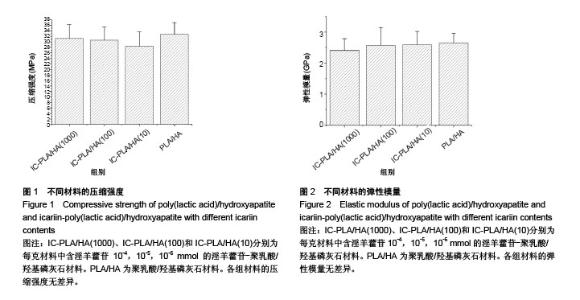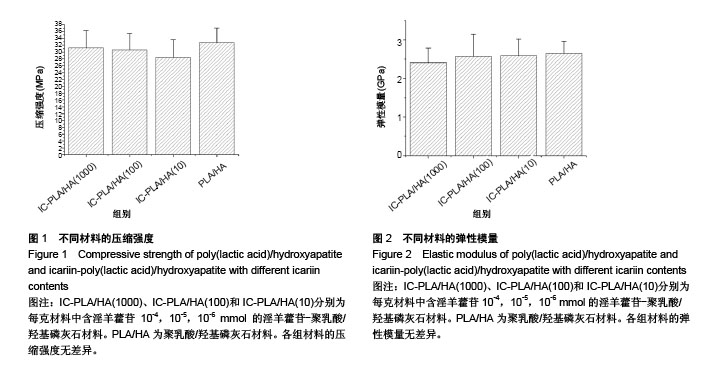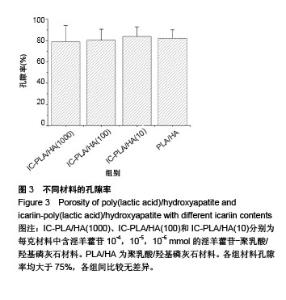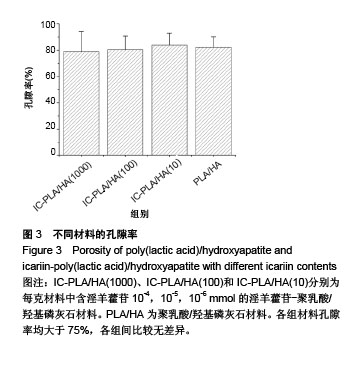Chinese Journal of Tissue Engineering Research ›› 2018, Vol. 22 ›› Issue (18): 2789-2794.doi: 10.3969/j.issn.2095-4344.0786
Preparation of icariin-poly(lactic acid)/hydroxyapatite composite bone-graft substitutes by supercritical carbon dioxide method
Zhang Yu-min1, Wang Jian-ru2, Han Bo1, Niu Xiao-jun1
- 1Shanxi University of Chinese Medcine, Taiyuan 030024, Shanxi Province, China; 2Shanxi Medical University, Taiyuan 030006, Shanxi Province, China
-
Received:2018-01-11Online:2018-06-28Published:2018-06-28 -
Contact:Zhang Yu-min, Shanxi University of Chinese Medcine, Taiyuan 030024, Shanxi Province, China -
About author:Zhang Yu-min, M.D., Associate professor, Shanxi University of Chinese Medcine, Taiyuan 030024, Shanxi Province, China -
Supported by:the Natural Science Foundation of Shanxi Province of China, No. 201601D011126; Scientific Research Fund for the Doctoral Young Scholars, Shanxi University of Chinese Medicine, No. 2014bk05; Shanxi Scientific Research Fund of Traditional Chinese Medicine, No. 2016ZYYC02
CLC Number:
Cite this article
Zhang Yu-min, Wang Jian-ru, Han Bo, Niu Xiao-jun. Preparation of icariin-poly(lactic acid)/hydroxyapatite composite bone-graft substitutes by supercritical carbon dioxide method[J]. Chinese Journal of Tissue Engineering Research, 2018, 22(18): 2789-2794.
share this article
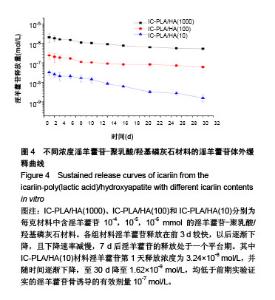
2.3 不同浓度淫羊藿苷-聚乳酸/羟基磷灰石材料的淫羊藿苷体外缓释特性 图4为不同浓度淫羊藿苷-聚乳酸/羟基磷灰石材料淫羊藿苷体外缓释情况,由图可知,各组材料淫羊藿苷释放在前3 d较快,以后逐渐下降,且下降速率减慢,7 d后淫羊藿苷的释放处于一个平台期。其中IC-PLA/HA(10)材料淫羊藿苷第1天释放浓度为3.24× 10-8 mol/L,并随时间逐渐下降,至30 d降至1.62×10-9 mol/L,均低于前期实验证实的淫羊藿苷骨诱导的有效剂量 10-7 mol/L。IC-PLA/HA(100)材料淫羊藿苷第1天释放浓度为2.42×10-7 mol/L,至第9天降至9.80×10-8 mol/L,之后淫羊藿苷维持在一个较稳定浓度,至30 d为6.18×10-8 mol/L,均接近淫羊藿苷有效浓度。 IC-PLA/HA(1000)材料淫羊藿苷第1天释放浓度为2.05×10-6 mol/L,高于淫羊藿苷有效浓度,考虑到材料在实际应用时多大于1 g,故综合考虑选取IC-PLA/HA(100)材料作为淫羊藿苷复合最佳比例。"
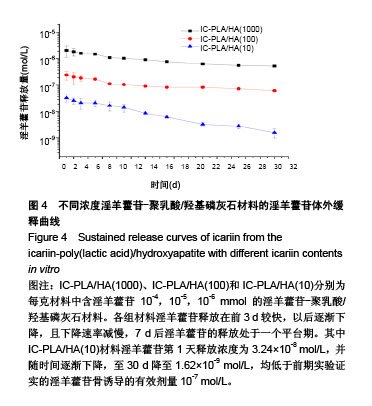
| [1] Windhager R,Hobusch GM,Matzner M.Allogeneic transplants for biological reconstruction of bone defects.Orthopade. 2017; 46(8):656-664.[2] Divi SN,Mikhael MM.Use of Allogenic Mesenchymal Cellular Bone Matrix in Anterior and Posterior Cervical Spinal Fusion: A Case Series of 21 Patients.Asian Spine J. 2017;11(3):454-462. [3] Hettwer W.Synthetic bone replacement:Current developments and perspectives Orthopade. 2017;46(8):688-700. [4] 罗有福,高金鉴,高浩然,等.负载重组人骨形态发生蛋白2的α型半水硫酸钙/纳米羟基磷灰石复合植骨材料的成骨性能研究[J].中国脊柱脊髓杂志,2016,26(4):348-353.[5] Iqbal H,Ali M,Zeeshan R,et al.Chitosan/hydroxyapatite (HA)/hydroxypropylmethyl cellulose (HPMC) spongy scaffolds-synthesis and evaluation as potential alveolar bone substitutes.Colloids Surf B Biointerfaces.2017;60:553-563.[6] 唐智明,熊龙,曾建华,等.中空羟基磷灰石复合重组人骨形态发生蛋白2微球体修复骨缺损[J].中国组织工程研究, 2017,21(2): 177-181.[7] Zhu X,Zhang H,Zhang X,et al.Dent Mater J.In vitro study on the osteogenesis enhancement effect of BMP-2 incorporated biomimetic apatite coating on titanium surfaces.Dent Mater J. 2017;36(5):677-685. [8] 臧晓龙,孙健,李亚莉,等.3D生物打印构建聚乳酸羟基乙酸/纳米羟基磷灰石支架骨形态发生蛋白2缓释复合体的实验研究[J].中国组织工程研究,2016,20(16):2405-2411.[9] Faundez A,Tournier C,Garcia M,et al.Bone morphogenetic protein use in spine surgery-complications and outcomes: a systematic review.Int Orthop.2016;40(6):1309-1319.[10] Lykissas M,Gkiatas I.Use of recombinant human bone morphogenetic protein-2 in spine surgery.World J Orthop, 2017;8(7):531-535.[11] 许静,张晶晶,郭非非,等.淫羊藿黄酮类主要成分促进骨髓间充质干细胞向成骨细胞增殖分化作用及机制的影响[J].中国实验方剂学杂志,2017,23(14):113-120.[12] Wei Q,He M,Chen M,et al.Icariin stimulates osteogenic differentiation of rat bone marrow stromal stem cells by increasing TAZ expression.Biomed Pharmacother. 2017;91: 581-589.[13] Zhang SC,Feng PB,Mo GY,et al.Icariin influences adipogenic differentiation of stem cells affected by osteoblast-osteoclast co-culture and clinical research adipogenic.Biomed Pharmacother. 2017;88:436-442. [14] Li M,Gu Q,Chen M,et al.Controlled delivery of icariin on small intestine submucosa for bone tissue engineering.Mater Sci Eng C Mater Biol Appl.2017;71:260-267. [15] Wu T,Shu T,Kang L,et al.Icaritin, a novel plant-derived osteoinductive agent, enhances the osteogenic differentiation of human bone marrow- and human adipose tissue-derived mesenchymal stem cells.Int J Mol Med.2017;39(4):984-992.[16] 张黎声,韩小晶,罗志荣,等.淫羊藿苷对大鼠骨髓间充质干细胞迁移作用的影响[J].中国中医药信息杂志,2017,24(2):44-48.[17] 鲍远,黄俊明,靖兴志,等.淫羊藿苷促进骨髓间充质干细胞成骨分化[J].中国组织工程研究,2016,20(24):6501-3507.[18] 曲美娟,丁超,王屹博,等.加载在种植体表面的淫羊藿苷对骨结合的影响[J].现代口腔医学杂志,2016,30(6):330-333.[19] Zhang Y,Wang J,Wang J,et al. Preparation of porous PLA/DBM composite biomaterials and experimental research of repair rabbit radius segmental bone defect.Cell Tissue Bank.2015;16(4):615-622.[20] Liu X,Yang L,Li J,et al.GS/DBM/PLA porous composite biomaterial for the treatment of infective femoral condyle defect in rats.Exp Ther Med.2016;11(6):2107-2116.[21] Han FY,Thurecht KJ,Whittaker AK,et al.Bioerodable PLGA-Based Microparticles for Producing Sustained-Release Drug Formulations and Strategies for Improving Drug Loading. Front Pharmacol. 2016;7:185.[22] Scognamiglio F,Blanchy M,Borgogna M,et al.Effects of supercritical carbon dioxide sterilization on polysaccharidic membranes for surgical applications.Carbohydr Polym. 2017; 173:482-488.[23] Zhang R,Ma PX.Poly(alpha-hydroxyl acids)/hydroxyapatite porous composites for bone tissue engineering. I. Preparation and morphology.J Biomed Mater Res.1999;44:446-455. [24] 吴涛,吴金辉,郑国栋,等.仿生组装淫羊藿苷-壳聚糖/羟基磷灰石骨修复材料的体外释药行为[J].中国组织工程研究, 2014, 18(52):8399-8404.[25] 唐俊杰,李文杰,李根,等.骨组织工程诱导性支架材料修复骨缺损[J].中国组织工程研究, 2015,19(3):340-346.[26] Zhang Y, Wang J, Ma Y, et al. Preparation and biocompatibility of demineralized bone matrix/sodium alginate putty.Cell Tissue Bank.2017;18(2):205-216.[27] Kim HS, Park JC, Yun PY, et al.Evaluation of bone healing using rhBMP-2 soaked hydroxyapatite in ridge augmentation: a prospective observational study.Maxillofac Plast Reconstr Surg.2017;25;39(1):40.[28] Zhang Y, Wang J, Ma Y, et al.Preparation of poly(lactic acid)/sintered hydroxyapatite composite biomaterial by supercritical CO2.Biomed Mater Eng.2018;29(1):67-79. [29] 张艳丽.二氧化钛纳米管负载淫羊藿苷对骨髓间充质干细胞及成骨细胞的影响[D].南方医科大学,2015. [30] Lai Y, Cao H,Wang X,et al.Porous composite scaffold incorporating osteogenic phytomolecule icariin for promoting skeletal regeneration in challenging osteonecrotic bone in rabbits.Biomaterials.2018;153:1-13.[31] Wang Q,Cao L,Liu Y,et al.Evaluation of synergistic osteogenesis between icariin and BMP2 through a micro/meso hierarchical porous delivery system.Int J Nanomedicine.2017;19;12:7721-7735.[32] 朱鸿飞,郑军,徐小燕,等.不同浓度淫羊藿苷修复骨损伤:争议与探索[J].中国组织工程研究, 2014,18(2):301-306.[33] 张秀珍,杨黎娟.淫羊藿苷对大鼠成骨细胞护骨素、RANKL表达的影响[J].中华内分泌代谢杂志,2006,22(3):222-225.[34] Wei Q,He M,Chen M,et al.Icariin stimulates osteogenic differentiation of rat bone marrow stromal stem cells by increasing TAZ expression.Biomed Pharmacother. 2017;91: 581-589. [35] Wu Y,Cao L,Xia L,et al.Evaluation of Osteogenesis and Angiogenesis of Icariin in Local Controlled Release and Systemic Delivery for Calvarial Defect in Ovariectomized Rats.Sci Rep.2017;7(1):5077. |
| [1] | Zhang Tongtong, Wang Zhonghua, Wen Jie, Song Yuxin, Liu Lin. Application of three-dimensional printing model in surgical resection and reconstruction of cervical tumor [J]. Chinese Journal of Tissue Engineering Research, 2021, 25(9): 1335-1339. |
| [2] | Zeng Yanhua, Hao Yanlei. In vitro culture and purification of Schwann cells: a systematic review [J]. Chinese Journal of Tissue Engineering Research, 2021, 25(7): 1135-1141. |
| [3] | Xu Dongzi, Zhang Ting, Ouyang Zhaolian. The global competitive situation of cardiac tissue engineering based on patent analysis [J]. Chinese Journal of Tissue Engineering Research, 2021, 25(5): 807-812. |
| [4] | Wu Zijian, Hu Zhaoduan, Xie Youqiong, Wang Feng, Li Jia, Li Bocun, Cai Guowei, Peng Rui. Three-dimensional printing technology and bone tissue engineering research: literature metrology and visual analysis of research hotspots [J]. Chinese Journal of Tissue Engineering Research, 2021, 25(4): 564-569. |
| [5] | Chang Wenliao, Zhao Jie, Sun Xiaoliang, Wang Kun, Wu Guofeng, Zhou Jian, Li Shuxiang, Sun Han. Material selection, theoretical design and biomimetic function of artificial periosteum [J]. Chinese Journal of Tissue Engineering Research, 2021, 25(4): 600-606. |
| [6] | Liu Fei, Cui Yutao, Liu He. Advantages and problems of local antibiotic delivery system in the treatment of osteomyelitis [J]. Chinese Journal of Tissue Engineering Research, 2021, 25(4): 614-620. |
| [7] | Li Xiaozhuang, Duan Hao, Wang Weizhou, Tang Zhihong, Wang Yanghao, He Fei. Application of bone tissue engineering materials in the treatment of bone defect diseases in vivo [J]. Chinese Journal of Tissue Engineering Research, 2021, 25(4): 626-631. |
| [8] | Zhang Zhenkun, Li Zhe, Li Ya, Wang Yingying, Wang Yaping, Zhou Xinkui, Ma Shanshan, Guan Fangxia. Application of alginate based hydrogels/dressings in wound healing: sustained, dynamic and sequential release [J]. Chinese Journal of Tissue Engineering Research, 2021, 25(4): 638-643. |
| [9] | Chen Jiana, Qiu Yanling, Nie Minhai, Liu Xuqian. Tissue engineering scaffolds in repairing oral and maxillofacial soft tissue defects [J]. Chinese Journal of Tissue Engineering Research, 2021, 25(4): 644-650. |
| [10] | Xing Hao, Zhang Yonghong, Wang Dong. Advantages and disadvantages of repairing large-segment bone defect [J]. Chinese Journal of Tissue Engineering Research, 2021, 25(3): 426-430. |
| [11] | Chen Siqi, Xian Debin, Xu Rongsheng, Qin Zhongjie, Zhang Lei, Xia Delin. Effects of bone marrow mesenchymal stem cells and human umbilical vein endothelial cells combined with hydroxyapatite-tricalcium phosphate scaffolds on early angiogenesis in skull defect repair in rats [J]. Chinese Journal of Tissue Engineering Research, 2021, 25(22): 3458-3465. |
| [12] | Wang Hao, Chen Mingxue, Li Junkang, Luo Xujiang, Peng Liqing, Li Huo, Huang Bo, Tian Guangzhao, Liu Shuyun, Sui Xiang, Huang Jingxiang, Guo Quanyi, Lu Xiaobo. Decellularized porcine skin matrix for tissue-engineered meniscus scaffold [J]. Chinese Journal of Tissue Engineering Research, 2021, 25(22): 3473-3478. |
| [13] | Mo Jianling, He Shaoru, Feng Bowen, Jian Minqiao, Zhang Xiaohui, Liu Caisheng, Liang Yijing, Liu Yumei, Chen Liang, Zhou Haiyu, Liu Yanhui. Forming prevascularized cell sheets and the expression of angiogenesis-related factors [J]. Chinese Journal of Tissue Engineering Research, 2021, 25(22): 3479-3486. |
| [14] | Liu Chang, Li Datong, Liu Yuan, Kong Lingbo, Guo Rui, Yang Lixue, Hao Dingjun, He Baorong. Poor efficacy after vertebral augmentation surgery of acute symptomatic thoracolumbar osteoporotic compression fracture: relationship with bone cement, bone mineral density, and adjacent fractures [J]. Chinese Journal of Tissue Engineering Research, 2021, 25(22): 3510-3516. |
| [15] | Liu Liyong, Zhou Lei. Research and development status and development trend of hydrogel in tissue engineering based on patent information [J]. Chinese Journal of Tissue Engineering Research, 2021, 25(22): 3527-3533. |
| Viewed | ||||||
|
Full text |
|
|||||
|
Abstract |
|
|||||
